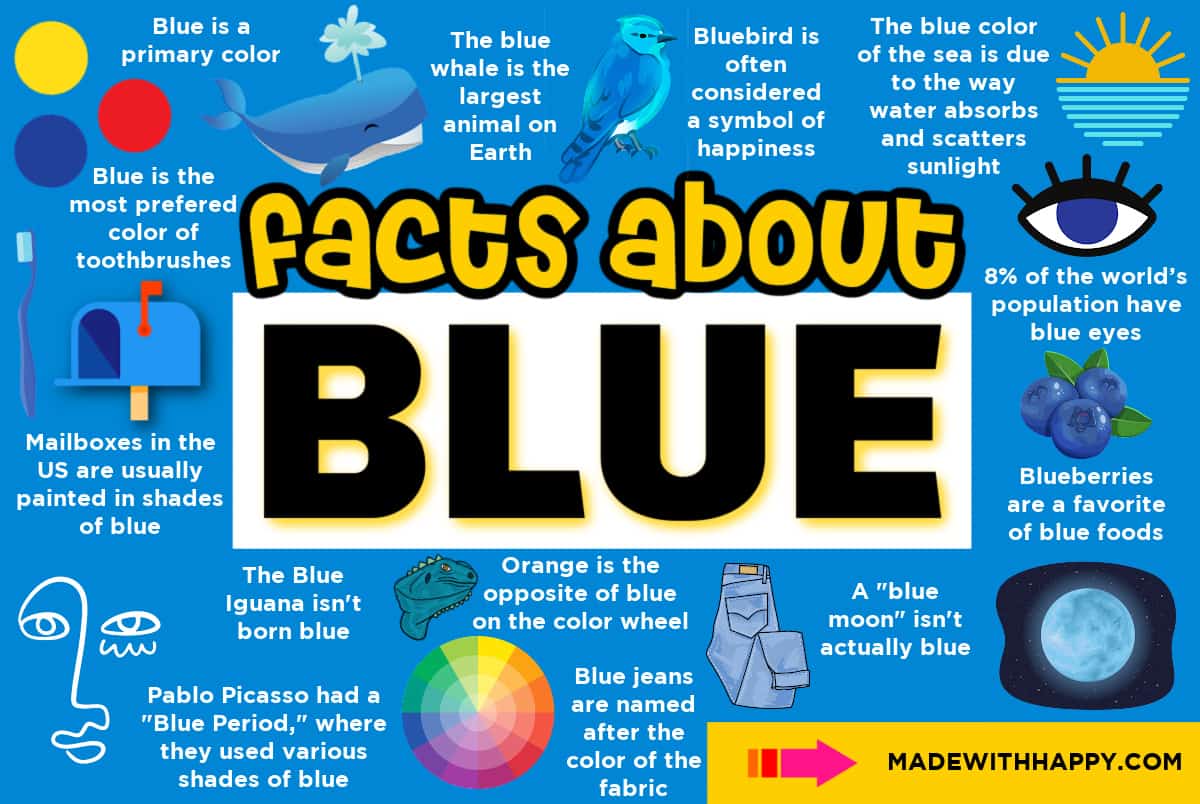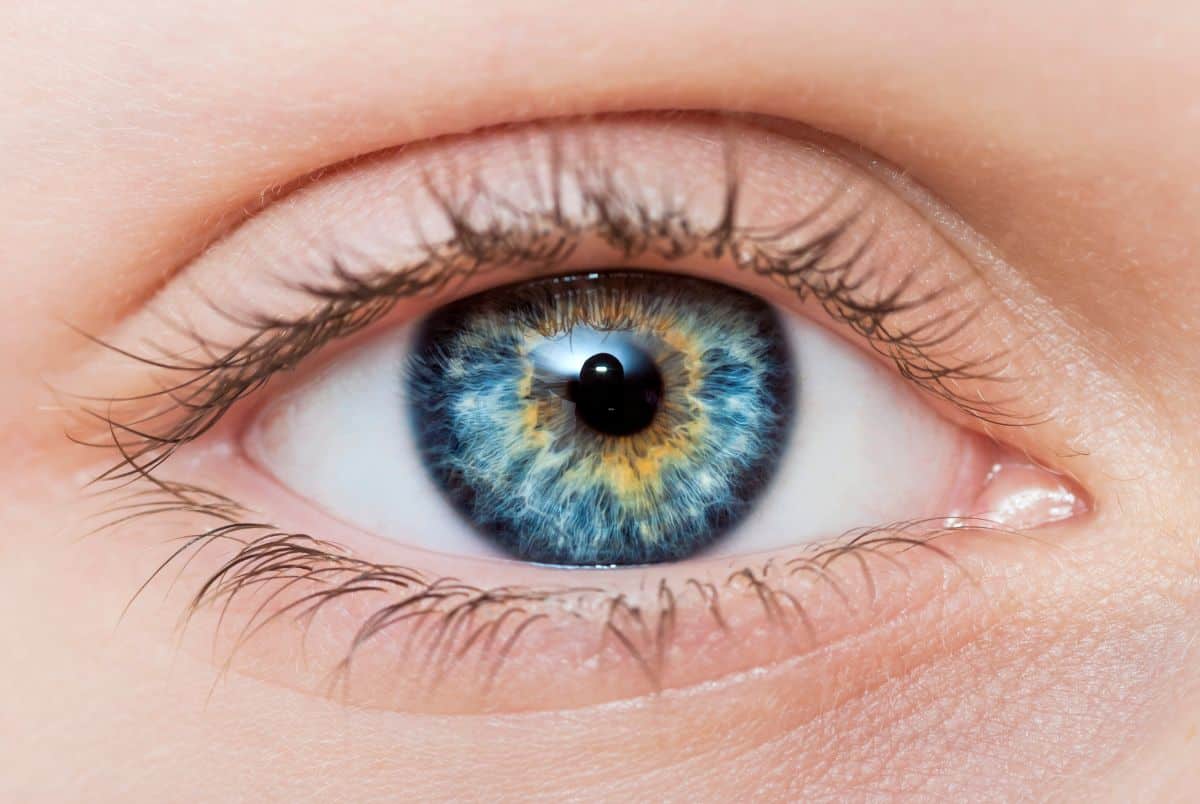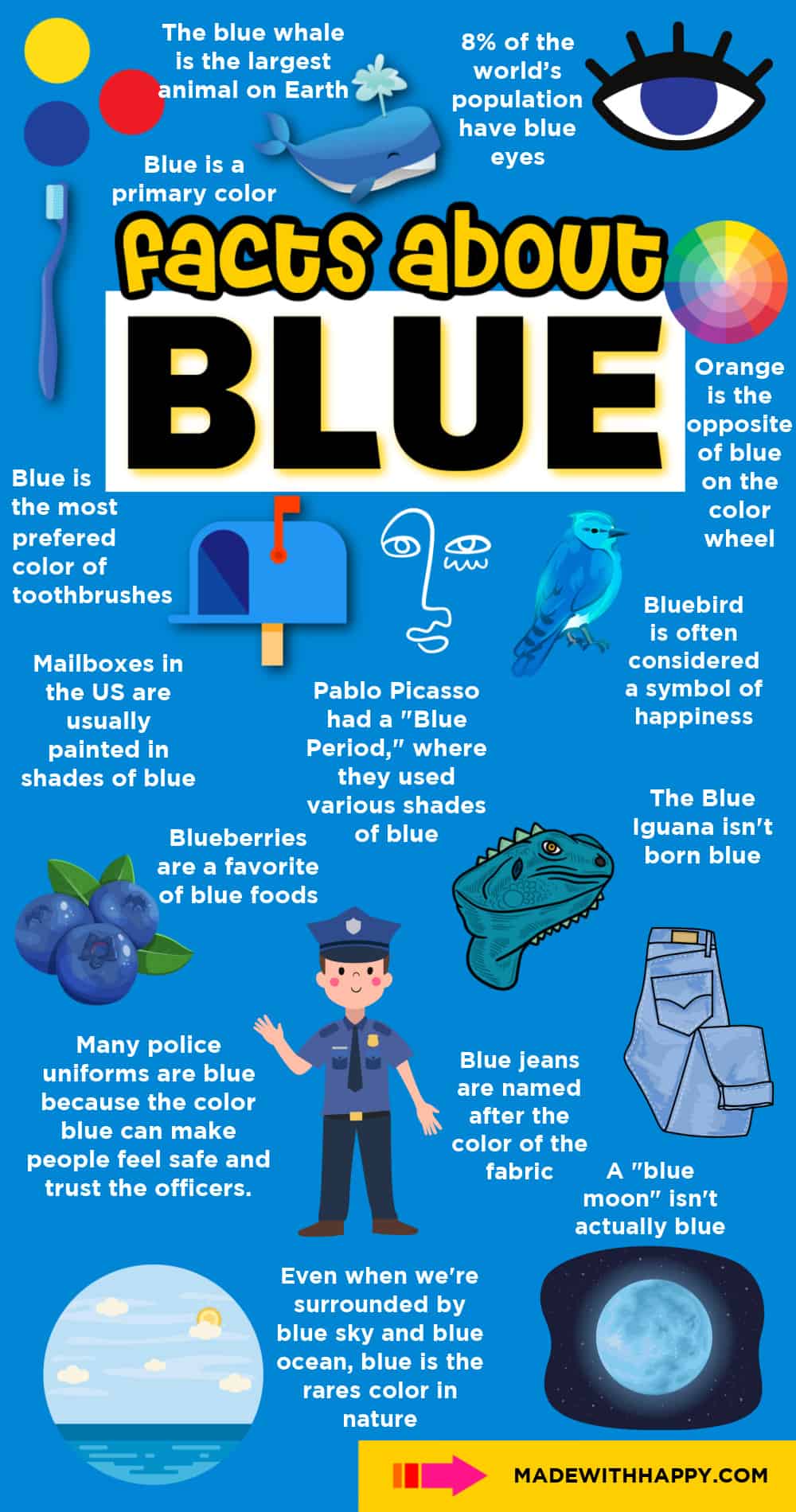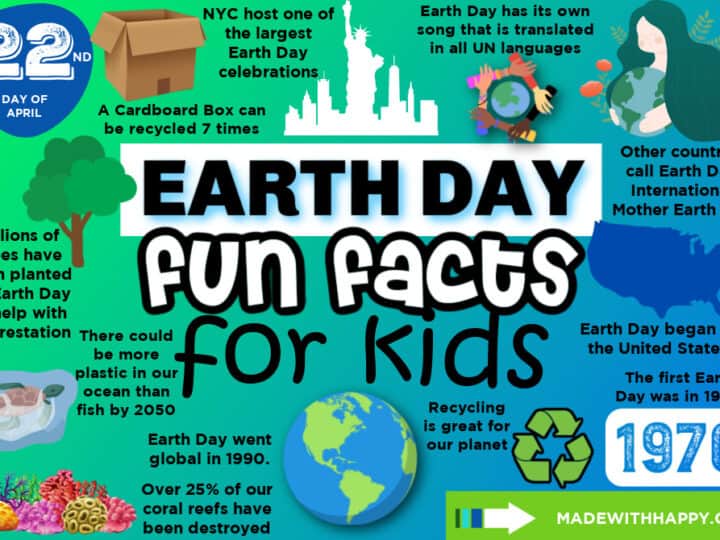Discover cool facts about the color blue! Learn why the sky is blue and more fun info. Dive into the world of blue!

Get ready to learn all about the color blue! It's everywhere, from the sky to the sea. We're sharing interesting facts about blue and how it's important in nature, art, and culture. Whether you love art, science, or just curious stuff, stick around and explore the cool world of blue with us!
Check out our 365+ Fun Facts For Kids

Want to save this project?
Enter your email below, and then we'll send it straight to your inbox. Plus get awesome new projects from us each week.
History of The Color Blue
Blue is a fascinating color with a rich history that goes back over 6,000 years. One of the earliest forms of blue pigment was "Egyptian blue," created by the ancient Egyptians. They used it to decorate tombs, pottery, and jewelry. They created this vibrant blue by mixing sand, limestone, and copper, showcasing their early mastery of color.
Jumping forward in history, during the Roman Empire, a precious ultramarine blu pigment called "lapis lazuli" was highly sought after. It came from Afghanistan and was used to create the beautiful blue hues seen in Roman frescoes and mosaics.
In the 18th century, a chemist named Johann Jacob Diesbach accidentally discovered "Prussian blue" while trying to make a red pigment. This new blue pigment quickly became popular in art and fashion. It's even used in some blueprints today!

Moving on to the 20th century, artists like Pablo Picasso had a "Blue Period," where they used various shades of blue in their paintings to express deep emotions. Another artist, Yves Klein, created his own unique blue called "International Klein Blue" for his artwork. He believed that blue had no dimensions and could represent the infinite.
Finally, let's not forget Sir Isaac Newton, who discovered that when light passes through a prism, it can split into the colors of the rainbow, including blue. This helped scientists understand more about the nature of colors, including different shades of blue. Blue has truly come a long way in its journey through history, from ancient times to the modern art world, leaving its mark in various shades, pigments, and dyes.

Where Did the Word Blue Come From?
The word "blue" comes from the Old English word "blǣwen," which means "blue" or "dark." Over time, the word evolved into "bleu" in Old French and eventually became "blue" in modern English. The origins of words can be quite fascinating!

Blue Color Wavelengths
Light is made up of different colors, like a rainbow. Each color has its own special wavelength, which is like a measurement of how long one wave of light is. Blue light, in particular, has shorter wavelengths compared to colors like red or orange which have longer wavelengths. These shorter wavelengths mean that blue light waves bounce around really quickly.
Because blue light waves are zipping around so fast, they can be a bit tricky for the human eye to handle. But our eyes are pretty amazing! They take in those fast-moving blue waves and turn them into the beautiful blue colors we see all around us, like the sky on a clear day.
Next time you look at something blue, remember that it's all about those special wavelengths of light making your world colorful and exciting!

What Colors Make Blue
Primary colors are like the building blocks of all other colors. There are three primary colors: red, blue, and yellow. These colors are special because you can't mix other colors together to create them. They're like the starting point for all the colors you see around you.
When we want to make the color blue, we actually don't mix any colors together like we do with some other colors. Instead, blue is one of the primary colors itself! So, we don't need to mix anything to get blue; it's a color that stands on its own.
However, if you're thinking about creating different shades or tones of blue, that's when we start mixing. By adding a bit of white, we can make a lighter shade of blue, like the sky on a sunny day. And if we mix a small amount of black, we can get a darker, richer blue, like the deep ocean. So, while blue itself is a primary color, we can still play with it and create all sorts of beautiful blue variations!

Meaning of the Color Blue
The color blue carries various meanings in different cultures around the world, and it's fascinating to see how people interpret this beautiful hue.
In many cultures, blue is often associated with feelings of calm and serenity. It's like a peaceful, clear sky or a tranquil ocean. This connection to calmness is why you might see blue used in bedrooms or meditation spaces to create a soothing atmosphere. Blue is like a deep breath for your eyes!
On the flip side, blue can also symbolize sadness or a feeling of being down, which is why we say someone might be feeling "blue" when they're not in the best mood. But don't worry; blue can also represent hope and optimism. For example, in some cultures, blue is linked to hope and a bright future.
In different parts of the world, blue can have unique meanings. For instance, in some Eastern cultures, it represents immortality and wisdom.
In other cultures, people connect it to spirituality and divine energy. So, the color blue is like a chameleon, changing its meaning depending on where you are and what you believe in, but it always brings a sense of depth and emotion to the world of colors.

Blue Things In Nature
Nature is full of amazing blue things, from the endless sky to the colorful creatures that make our world a little more vibrant
- The sky is blue, and we see lots of blue in oceans, but surprisingly, blue is the rarest color to find in nature.
- The blue color in plants and fruits comes from a pigment called anthocyanin.
- Blueberries are a favorite of blue foods, known for their delicious taste and health benefits.
- The blue color of the sea is due to the way water absorbs and scatters sunlight.
- Blue flowers, like forget-me-nots and hydrangeas, add beauty to gardens.
- A "blue moon" doesn't actually mean the moon turns blue. It refers to the second full moon in a calendar month.
- Rayleigh scattering is a scientific phenomenon that explains why the color blue is scattered more than other colors by Earth's atmosphere, making the sky appear blue during the daytime.

Blue Animal Fun Facts
Get ready to explore the enchanting world of blue animals, where we'll discover fascinating facts about creatures that flaunt this captivating color and others!
- Peacock feathers can sometimes look green or brown from certain angles because of the way light interacts with their microscopic feather structures. So, their blue can magically transform into other colors depending on how you look at it!
- The blue jay is a noisy and colorful bird found in North America.
- Some butterflies, like the Morpho butterfly, have vibrant blue wings.
- The bluebird is often considered a symbol of happiness and good luck.
- The blue whale is the largest animal on Earth and gets its name from its bluish-gray skin.
- Blue iguanas aren't actually blue when they're born! They start off as a grayish-green color and gradually turn blue as they get older

Facts About The Color Blue
- Blue is the most popular color for many people around the world.
- Orange is the opposite of blue on the color wheel and is called its complementary color.
- The color blue has a Biblical meaning symbolizing holiness and God's presence, as seen in the Virgin Mary's blue robes in Christian art.

- Blue eyes are the result of less melanin in the irises, allowing light to scatter and create a blue appearance.
- Only 8% of the world’s population have blue eyes.

- Mailboxes in the United States are usually painted in shades of blue.
- Blue appears in the flags of numerous countries, symbolizing different ideas and values.
- The Blue Man Group is a famous performance art group renowned for painting their bodies blue.
- Public servants in Ancient Rome wore blue and that may be one of the reasons many of today’s police uniforms are blue.
- In ancient Rome, blue clothing was worn as a symbol of social status and wealth.

Other Color Blue Facts
- Blue diamonds are super rare and worth a lot of money, making them some of the most precious gemstones on Earth.
- The "Blue Marble" is a famous photograph of Earth taken from space.
- In movies, filmmakers use the blue screen for special effects, enabling them to add different backgrounds later.
- Blue jeans, a popular clothing item, are named after the color of the fabric.
- Most people like to pick blue for their toothbrush color.

- People like to use blue for office decorations because research suggests that blue rooms can help people work better and get more done.
- According to a survey, women's sweaters in the color blue are the best-selling color, possibly because women believe that men find this color appealing.
- Many companies use the color blue in their logos to convey trustworthiness and professionalism.
- When people say "seeing red" to mean getting angry, it's interesting that looking at the color blue can actually make you feel calmer and reduce anger and stress!
- National Dress in Blue Day is the first Friday in March.

Blue Color Names - Shades of Blue
There are countless shades of blue, from sky blue to navy blue. Light blue, like the soft hue of the sky on a sunny day, is often linked to feelings of peace and tranquility. On the other hand, dark blue, as deep as the ocean's abyss, can evoke a sense of mystery and depth. These shades are created using different blue pigments and are like the many colors of blue we encounter in our lives.
Artists love to play with all these different shades of blue in their paintings. Think of a beautiful seascape where the ocean can have so many shades of blue that it looks like a living masterpiece. Blue can evoke emotions like calmness or excitement, depending on the shade an artist chooses.
Blue is all around us, from the waters of the ocean to the feathers of some birds like blue jays. It's in the clothes we wear, the flags that represent countries, and even the sky above us on a sunny day. Exploring the many shades of blue in our world is like discovering the colors of a hidden treasure chest! So, next time you look at the color blue, take a moment to appreciate the countless shades and the beauty they bring to our lives.

Other Color Activities You'll Enjoy

Download Blue Worksheet For Kids
Enter your email in the form below and you'll be taken directly to the blue worksheet for kids pdf file.
*For personal use only
CONNECT WITH MADE WITH HAPPY!
Be sure to follow me on social media, so you never miss a post!
Facebook | Twitter | Youtube | Pinterest | Instagram
Find and shop my favorite products on my Amazon storefront here!
Facts About The Color Blue
PIN IT TO YOUR DIY BOARD ON PINTEREST!
FOLLOW MADE WITH HAPPY ON PINTEREST FOR ALL THINGS HAPPY!






